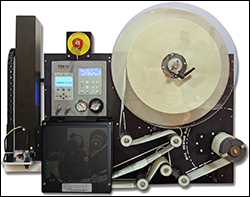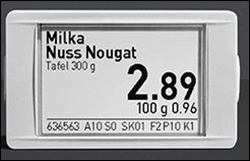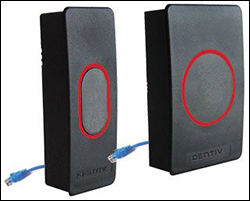Jun 25, 2015The following are news announcements made during the past week by the following organizations:
Fox IV Technologies;
Imagotag;
Cisco, Identiv;
SITA;
Gimbal, PlaceWise Media; and
AIM.
Fox IV Introduces New RFID Printer-Applicator
Fox IV Technologies has announced a new addition to its range of RFID printer-applicators, known as the SR2143LR, for the encoding, printing and application of high-frequency (HF) and ultrahigh-frequency (UHF) RFID labels. The new printer-applicator is built using a Datamax-O'Neil M-Class Mark II printer, and is able to generate HF and UHF RFID labels in an array of label sizes, media and inlay designs.
The device features integrated auto calibration and short-pitch encoding. For HF RFID, the SR2143LR complies with the ISO 15693 standard, and for UHF RFID, it complies with the EPC Gen 1 and Gen 2 standards. The modular design means that the entire assembly can be removed and replaced or upgraded as necessary. According to Fox IV, the print engine and ribbon assembly are separate, removable modules. Additionally, the company reports, a variety of applicator assembly options for applying the label to the product (tamp, tamp-blow, wipe and so forth) are available. The units come with a large-capacity unwind assembly that can hold up to a 16-inch roll of labels or tags—which the company says works well for high throughput and extended production runs.
The new printer-applicator also features the company's Out-of-Spec Tag Handling System to detect out-of-spec tags before they are passed through the supply chain. According to the company, the printer-applicator signals that a tag is out-of-spec or dead, and the signal initiates a process to print "VOID" on the tag and activate the Tag Handling System. From there, the solution allows the label to remain on the label liner by not peeling it at the printer-applicator peel point. Instead, it simply rolls over the peel point and is taken up on the rewind as part of the spent liner. If there are three "bad" tags in a row, the company indicates, the unit goes into fault mode.
Fox IV also manufactures other printer-applicator units incorporating different print engines, including Zebra Technologies' ZE500-4R print module, any of SATO's S84SE print modules, Datamax-O'Neil's A-Class Mark II print module and Avery Dennison's DPM module. All of these are plug-and-play modules that enable the print engine to be easily swapped out. The company also offers a unit with Printronix's T5000r RFID printer-encoder. Each of these models is UHF-only.
Imagotag Announces Multimillion-Euro ESL Contract With International Retailer
Imagotag, an Austrian electronic shelf labels (ESL) specialist, has announced that it has signed an exclusive contract with a leading international retailer to install its ESL solution within 250 stores across Europe.
The contract is valued at €35 million ($55 million), Imagotag reports, and follows several months of operational pilot projects and initial installations throughout three European countries. The solution includes two million e-paper digital interactive labels in small, medium and large sizes, featuring both standard and color displays.
Imagotag's access points operate in the 2.4 GHz frequency band to communicate with electronic shelf labels and update their e-paper displays. The firm does not use a standard Wi-Fi protocol for the communication of the access points and the labels; if it did, one of Imagotag's access points would not be able to control as many labels as it is designed to do (which is currently up to about 10,000 labels), according to Melanie Almer, a spokesperson for Imagotag. "Further, it would be impossible to achieve a battery lifetime of over five years," she adds. "To provide a combined solution for Wi-Fi and ESL management in one device, we introduced our new access point, MAP-2014, some months ago. It is unique on the market and opens up great new possibilities."
This large-scale deployment of the Imagotag solution is part of the retailer's digital strategy and development of its online sales channels and network of physical sales outlets, according to Imagotag. The electronic labels will synchronize the online and physical sales channels, the company adds, while simultaneously increasing pricing agility, pricing accuracy and store operational efficiency. The project is also designed to implement in-store shopper connectivity.
The labels are directly linked to the database of the retailer's enterprise resource planning (ERP) and point-of-sale (POS) systems. If a price change occurs, the software will push the change automatically to the label, ultimately eliminating discrepancies between the price stored in the system and that shown at the shelf. Moreover, price changes across multiple products can be carried out quickly and automatically, thereby improving operational efficiencies.
The company reports that there are a variety of other ways in which its ESL solutions can be used. For example, they can be utilized for location tracking. By determining where the labels—matched with specific products—are located in a shop, it can guide customers to those goods. Additionally, each ESL functions as a Near Field Communication (NFC) tag, so shoppers can use their NFC-compatible devices, such as a smartphone, to identify each label and the product to which it is connected. Via a special app, for example, retailers can list products related to the one being displayed (for example, it can provide a recipe using the displayed product and then tell the customer where in the store to find the additional items required for that recipe), as well as personalized discounts and rewards, mobile self scan-to-pay, rich content and media—all at the product shelf.
In December 2014, Imagotag partnered with Lancom Systems, a German manufacturer of networking solutions for the commercial and public sectors, on its new E-series access points that support the simultaneous operation of three different radio technologies: wireless LAN (Wi-Fi), electronic shelf labels and Bluetooth Low Energy (Bluetooth Smart) beacons (see Lancom Systems' New Device Combines Wi-Fi, Bluetooth Beacon and Electronic Shelf Label Functionality).
Earlier that year, in February, Imagotag announced a strategic and financial alliance with SES Group, in which SES acquired a minority interest as part of an exclusive Memorandum of Understanding signed by SES and Imagotag for SES's acquisition of 100 percent of Imagotag over a two-year period. SES has worked on other ESL deployments with retailers, including E.Leclerc hypermarkets (see Retailers Adopt NFC-enabled Electronic Shelf Labels). Currently, in the two-brand strategy within the alliance of SES and Imagotag, SES's access points and the labels communicate via the low-frequency (LF) 36 kHz band.
Cisco, Identiv Collaborate on RFID-enabled Physical Access Security
Identiv and Cisco Systems are collaborating to deliver a networked, RFID-enabled physical access control system (PACS) that can be used with Internet of Everything (IoE) elements, such as such as Cisco Video Surveillance Manager (VSM) cameras and Cisco voice-over-IP (VoIP) telephony products. Cisco's and Identiv's joint technology will meet the market need for a trusted solution that addresses the security concerns surrounding IoE, Identiv reports.
The IoE is the intelligent connection of people, processes, data and things to the Internet that will bring new economic opportunities to the private and public sectors, according to Identiv. Utilizing 61 real-world use cases, Identiv reports, Cisco's consultants have calculated that IoE-based solutions can deliver $19 trillion in economic value worldwide throughout the next decade.
The initial PACS solution is based on the Cisco Physical Access Manager (CPAM), which Identiv plans to launch later this summer as its iPAM branded product. Identiv and Cisco are working together to offer enhancements to iPAM and Identiv's other products, in order to provide support for IoE offerings. In the near term, these IoE extensions will provide the current customer base of Cisco and Identiv PACS products with additional data and services to enhance the functionality and security of their systems. Over time, there will be greater integration between these systems and traditional IT, as well as mobile offerings, to improve the user experience and further enhance security.
As part of the solution, Identiv will offer a new network-based PoE door controller and its uTrust TS door reader, which supports all common access credentials on the market, as well as legacy wiring and network connections. During the months following the launch, Identiv says it plans to release updates to iPAM with new features and functionality.
Cisco will resell iPAM and the other components of the access-control solution as part of its physical security solution lineup, which will include SmartID credentials from the cloud-based Identiv idOnDemand service. The identity-management service removes overhead expenses and the costs of owning and maintaining printers and cards. Specifically, the service provides identity and credential management for people as a cloud service. Benefits include the ability to enroll new employees and issue badges containing cryptographic credentials; links to enable physical access to buildings, using the credentials on the badge; the enabling of logical access using the cryptographic credentials; secure login; access to secure portals (for example, websites using HTTPS with client-side PKI authentication); e-mail signing and encryption; document signing; lifecycle management of the credentials; and employee suspension or termination.
The idOnDemand service bureau handles the programming of a customer's physical access formats in the cloud, and finished cards are then shipped to the customer ready to use. The customer's digital credentials are used to secure and control information; an idOnDemand SmartID can encrypt and digitally sign digital documents so the customer need not worry about a cloud provider securing the information. In addition, Identiv cloud-issued idOnDemand SmartIDs can be produced with the capability of generating one-time passwords (OTP) based on Open Authentication (OATH). This can be done using any NFC-enabled device and an idOnDemand SmartID. It allows secure communication via any network, the company reports, and allows users to log in with two-factor authentication. Users can also use this to turn any NFC-enabled phone into an OTP token.
Beacon Adoption by Airlines Set to Soar, New SITA Report Finds
Bluetooth beacons are just getting their start in the air transport industry. In fact, only about 9 percent of airlines have experimented with beacons to date, according to a new report from SITA, an information technology and services provider for the air-transport sector. But SITA estimates that will change quite dramatically, and that during the next three years, the number of airlines starting beacon projects will soar nearly five-fold, to 44 percent.
SITA sent questionnaires to a senior IT executive at each of the top 200 passenger carriers during this past spring. The survey, which represents the views and insights of more than half of the top 100 carriers, found that beacons are currently deployed primarily in airport check-in areas, but also at places within an airport where passengers dwell and transfer between flights, with the most common service provided by airlines being the delivery of flight and gate information. Specifically, 8 percent of survey respondents said they use beacons now for wayfinding services, 14 percent for flight and gate information, 7 percent for baggage collection, 3 percent for walk-to-gate times, and 5 percent for duty-free offers. With the expected growth, the survey found that airlines are planning to use the beacons largely for wayfinding services from check-in to gate. The specific breakdowns by 2018 are 57 percent for wayfinding services, 49 percent for flight and gate information, 40 percent for baggage collection, 34 percent for walk-to-gate times, and 29 percent for duty-free offers.
The report also notes that Internet of Things (IoT) technology is still in its infancy within air travel, but adoption is expected to mature fast during the coming years. As a result, an increasing number of physical items at the airport, as well as individuals through the devices they carry, will add to the amount of data collected for analytics purposes. At present, 86 percent of respondents said they expect the IoT to provide clear benefits during the next three years, while only 9 percent strongly agree that the IoT currently presents clear benefits. Airlines are thus taking a careful approach to investments in this area, SITA reports, with only 16 percent planning a major project, though 41 percent expect to make some R&D investment. Check-in is predicted to be the early beneficiary of the IoT, with 42 percent of respondents rating this as their top priority and 56 percent saying they would put it in their top three areas of benefit. Two out of five airlines also rate bag-drop within their top three areas of the customer journey that will benefit from IoT technology.
Gimbal, PlaceWise Media Partner on Beacons and Apps for Retailers
Gimbal, a provider of Bluetooth beacon and location-based engagement technologies, and PlaceWise Media, a provider of digital media services for the shopping center industry, have announced a partnership to provide Gimbal's proximity-engagement services to PlaceWise's client base of mall properties. PlaceWise has already begun installing Gimbal Proximity Beacons Series 21 across more than 60 premier malls and retail centers, which it expected to have completed by the end of this year.
The initial phase of deployment, which is already underway, includes 27 PlaceWise client properties. Gimbal's Bluetooth-enabled beacon platform, which includes Bluetooth Smart beacons with support for both iOS and Android, as well as software, is context-aware and offers geofencing, proximity, interest sensing, consumer privacy controls, a communication platform and more. It is designed to deliver targeted, real-time location data to trigger message campaigns based on arrival, departure and dwell times from custom geofenced areas. With this technology, Gimbal reports, PlaceWise is adding beacons to its proximity-marketing layer of Wi-Fi and geofencing capabilities. The partnership, according to Gimbal, means that PlaceWise's private digital network of nearly 700 shopping centers nationwide, currently exceeding 10 million monthly visitors, will be able to reach a broader audience of on-premise shoppers through all three components of mobile engagement.
AIM Creates New Committee to Promote Track and Trace for the Food Industry
AIM, an international industry association focused on bar-code, RFID, real-time location system (RTLS) and mobile-computing technologies, has announced that it has created a new committee dedicated to developing, promoting and aiding in the adoption of automatic identification strategies designed to support compliance of regulations related to food industry product traceability, and to provide education about this area.
Elizabeth Sinclair, an executive with Seagull Scientific's vertical markets team, will serve as the appointed chair of the Track & Trace committee. The initial meeting of the group will take place on Tuesday, June 30, at 1:00 PM ET, via a Web and phone conference.
With the addition of Track & Trace, the number of AIM and AIM North America committees supporting the automatic identification and data capture (AIDC) industry worldwide grows to seven. This includes the AIT Alliance, Healthcare, Internet of Things (IoT), RAIN RFID Alliance, RFID Experts Group (REG) and Technical Symbology Committee (TSC).
AIM says the new Track & Trace committee wants to build a solid base of industry experts from within AIM's current membership base and partners, as well as recruit additional individuals with a variety of experience in track-and-trace solutions. Individuals interested in participating with AIM's Track & Trace initiatives are asked to submit their information online at AIM Track & Trace, or to contact the organization directly via e-mail or phone (+1 724-742-4470).




